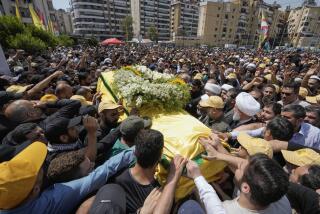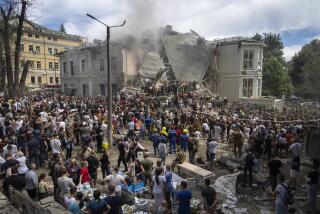NATO Intelligence System May Face Review
- Share via
WASHINGTON — Officials’ acknowledgment that the accidental bombing of the Chinese Embassy in Belgrade could have been the result of poor intelligence work may set off demands for a review of the entire data-gathering system used by NATO for its air campaign in Yugoslavia.
U.S. and NATO officials have mostly ruled out mechanical or pilot error, believing instead that “the fault here is in the targeting. . . . The weapon hit what it was supposed to,” said one U.S. official. “We just don’t know why.”
Three people were killed and 20 injured when two or more NATO precision munitions struck the embassy in downtown Belgrade, the Yugoslav capital, shortly after midnight Friday. The NATO pilots thought that they were striking a Yugoslav government building, closely involved in military work, called the federal Directorate of Supply and Procurement, officials said.
The bombing, swiftly denounced by Beijing as “barbaric,” came as the latest in a string of “collateral damage” incidents, including a strike late Friday on a hospital and market in Nis, Yugoslavia’s third-largest city. These incidents suggest that an air war billed as the most precise in history is becoming increasingly lethal to civilians as it intensifies.
The growing pace of unintended strikes has brought charges that NATO’s “surgical” air war is not precise at all and that too many civilians are being killed.
NATO officials acknowledge that there have been more incidents of civilian casualties in recent days. While some wonder if the string of accidental strikes indicates a new recklessness on the part of NATO or its pilots, officials insist that the incidents are a result of the heightened tempo of the air war, which now involves more than 900 aircraft and more than 600 sorties on many days.
Officials say there are limits to what even the new “precision” warfare can do. Air Force Maj. Gen. Charles Wald, for example, said recently that laser-guided bombs can be expected to hit their targets only 80% to 90% of the time.
“This is still beyond what you could expect, given the expected performance of these systems,” one military official said.
Earlier attacks on unintended targets have been blamed on pilot error or straying bombs. But one U.S. official said the facts of the embassy bombing suggest only two possibilities: Either the intelligence on the site was inaccurate or there was a foul-up in the way the targeting information was applied to direct the bomb to its target.
Another American official said the most likely cause is “stale information.”
The Chinese Embassy building has been occupied by the delegation for about two years, and some outside experts speculated that NATO planners may have simply failed to double-check their information before the bombing was ordered.
NATO planners in Brussels said they believed the building was a munitions storage depot.
If the lapse was caused by such an oversight, it would be surprising. The U.S. military’s target pickers usually use multiple sources of information to check their targets and observe various procedures to ensure that they do not hit the most sensitive sites, such as religious buildings, schools and hospitals.
In NATO’s 1995 air campaign against Bosnian Serb forces, for example, the U.S. military relied on an automated system that kept an inventory of highly sensitive sites. This system prevents target pickers from unwittingly selecting sensitive sites, experts say.
In planning for the 1991 Persian Gulf War, “we would always make sure we had at least two sources of information on the targets,” said Robert Gaskin, who, as an Air Force officer, helped choose targets for the air war against Iraq. “You can’t afford to make mistakes like this.”
The military accumulates information on its bombing targets from a wide variety of sources. They include electronic communication interceptions, satellite images, interviews with refugees and former workers in a country, spies and publicly available information.
Experts believe that U.S. officials have probably been accumulating information for years on possible targets in Serbia, Yugoslavia’s dominant republic, which, under the leadership of Slobodan Milosevic, has been in conflict with the United States for nearly a decade.
Yet it may be that targeters simply didn’t recheck their data on the embassy; it could not immediately be determined Saturday who occupied the building before the Chinese diplomats moved in.
Some experts say that, if this turns out to be the case, members of Congress may soon be asking the Pentagon why the intelligence-gatherers weren’t doing some basic spade work.
“The question is, why didn’t they have somebody doing a basic walk-around in downtown Belgrade?” said John Pike, a military and intelligence analyst at the Federation of American Scientists in Washington. He said that leaders of the congressional intelligence committees could ask whether this is not another example of why the United States needs more agents abroad.
U.S. officials declined to describe what kind of bombs or missiles were involved in the attack.
But because of the high concentration of air defense sites in the Belgrade area, the bombs were probably carried by a U.S.-built radar-evading F-117 fighter, experts say.
The munitions could have been laser-guided or satellite-guided, though the laser-guided variety might be considered preferable for striking a building in a crowded city because of their slightly greater accuracy.
This was not the first time U.S. warplanes have struck foreign embassies. During the Vietnam War, U.S. bombs struck the French Embassy in Hanoi, killing the charge d’affaires.
And during the April 1986 bombing of Tripoli, launched in retaliation for Libya’s killing of U.S. soldiers in a Berlin disco, U.S. warplanes struck the French, Romanian and Swiss embassies.
Since the Yugoslav air war began March 24, NATO warplanes have hit civilian targets in seven major incidents, NATO officials acknowledge. These include strikes on several residential areas, a train, at least one convoy of ethnic Albanian refugees and Friday’s strikes in Nis and on the Chinese Embassy.
Civilians were also killed May 1, when a bomb struck a bus in Kosovo. NATO has contended it has no evidence that allied warplanes were responsible for that incident.
More to Read
Sign up for Essential California
The most important California stories and recommendations in your inbox every morning.
You may occasionally receive promotional content from the Los Angeles Times.














